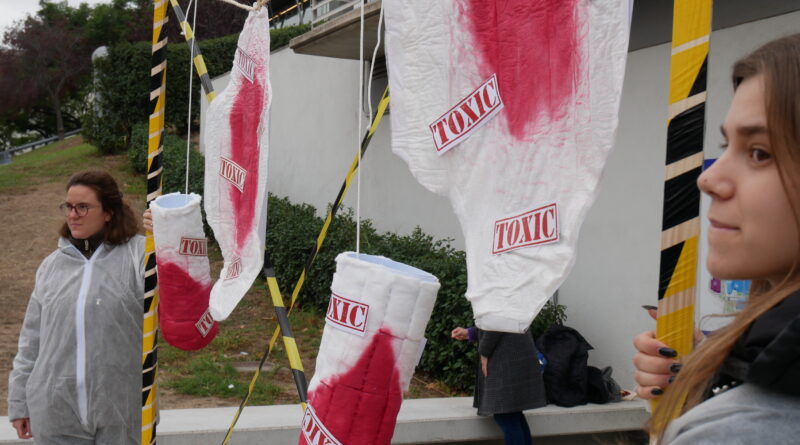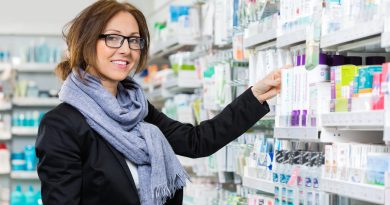Spanish environmental, feminist and health NGOs demand to eradicate toxics from menstrual products and more transparency from companies
On December 1, environmental, economic, feminist, and health collectives gathered in front of Woman Hospital and Child Hospital for a reason. They demand the governs the prohibition of toxic substances in menstrual products and require the companies to inform about their composition.
They have demonstrated the number of toxics that menstrual products contain through the stage representation of pads and giant tampons. With the slogan “For a menstruation free of toxics”, the collectives affirm that there is not enough information about the health risks that can cause the direct and prolonged exposure of these substances to the genital mucosa. They also complain that the manufacturers of menstrual products are not obliged to itemize the composition of the products in the labeling. Moreover, they fight for the right of consumers to have this information.
The action also has the support of hundreds of people, public administrations, and civil society organizations who join the claim through the collection of signatures from the Bloody Manifest. The collection of signatures is still prevailing and can be signed through this link.
Nowadays, single-use pads and tampons are the most used menstrual products and the predominant ones in the global and Catalan markets. Several surveys explain that this fact is due to the lack of information and accessibility to all the existing options of menstrual products, as well as the lack of transparency around the composition of single-use products and their impacts on people’s health and the environment.
Menstrual products are in contact with the vulva and vaginal mucosa, a highly sensitive and absorbent area of the body. However, these products do not have a specific regulation that determines the measures of their composition, product and use.
This regulation for menstrual products allows producers and distributors not to be obligated to break down their composition in the labeling, so we don’t know their absolute composition.
Pads are made of 90% plastics (polyethylene, polypropylene and polyester). They can also contain cellulose fibers and absorbent polymers. They have stickers on the bottom, and some have fragrances, coloring pigments, emulsifiers or moisturizing substances added to them. Tampons have a simpler composition. They are made of rayon or cotton core that is covered by polyethylene and polypropylene and joined by a thread that facilitates the extraction of the tampon form the body. This thread is made of polyester and/or polypropylene.
Although this is the main composition of tampons and pads, several analyzes of single-use menstrual products in laboratories have detected the presence of other substances recognized as toxics. These are endocrine disruptors which are substances that belong to the carcinogenic or mutagenic groups and toxic reproductive or skin-irritating substances. Most of the detected toxic substances hadn’t been intentionally added to the product.
Some of the substances that have been identified are:
- Dioxins and furans: polluting compounds produced unintentionally from the thermal processes of plastics and characterized by being very persistent, stable and bioaccumulative. Therefore, they are extremely toxic to some animals and humans.
- Several polycyclic aromatic hydrocarbons (PAHs): formed during the incomplete combustion of oil, among other substances.
- Phthalates, bisphenols and parabens: additives used to provide certain properties to plastics. Among the phthalates detected, there is dinoctyl phthalate or DnOP, banned in toys and articles for children (European Directive 2005/84/EC).
- Lilial®: a substance that provides fragrance but is prohibited in cosmetics in the European Union since March 2022 (Regulation 2021/1902/CE).
- Various types of residual pesticides from the non-organic cotton production process and derivatives. Some of these types are quintozene, hexachlorobenzene and lindane. These are organic compounds banned in the European Union since 2003, 2005 and 2008 (Regulation 2076/2002/EC, Rotterdam Convention and Stockholm Convention).
- Adhesives such as glutanotrile methyl dibrom.
Although many of these substances have been detected at residual levels, there is not enough information about health risks that can cause direct and prolonged exposure of these substances to the genital mucosa. Nor are the risks associated with the combined and cumulative effect of exposure to low doses of chemicals known. In addition, the existing analyzes are not sufficient to know the totality of substances found in single-use menstrual products. So far most of the toxins detected were not intentionally added to the products but are the result of manufacturing processes or contamination of raw materials. The last ones should be regulated in order to avoid health risks.
Statement by Rosa García, Rezero General Director:
The stigma about menstruation, still prevailing in our society, has produced that menstrual health hasn’t been considered a priority until today. In accordance with the precautionary principle, which must prevail in the composition of a product that is in contact with a sensitive area of the body as the vulva and vagina, it is inadmissible for menstrual products to contain toxic substances. Furthermore, some of these substances have been banned in the European Union for more than ten years.
The different collectives have read one by one what is requested. They say that to put an end to this situation and for all women and other menstruating people to live dignified and healthy menstruation and also enjoy their menstruation rights, it is necessary to:
According to Lorena Martinez of the Catalan Endometriosis Affected Association collective: “We are here to claim the prohibition of the presence of toxic substances, substances whose health safety cannot be ensured or any other strictly necessary additive in menstrual products”.
On the other hand, Mireia Fernández from the Objective Zero Waste collective of Santa Perpetua de la Mogoda, a representative of the environmental field, denounces the amount of waste that generates single-use menstrual products and the impunity of manufacturers towards people’s health and claims the transparency of information on the composition of products and mandatory labeling.
Finally, the signatory entities believe that it is essential to guarantee access to options that do not put people’s health and environment at risk, such as reusable products (menstrual cups, menstrual panties and cloth pads) and free bleeding.
Entity, associations and signatory groups:
– Associació d’Afectades de Endometriosis de Catalunya
– Apquira. Associació de Persones Afectades per Productes Químics i Radiacions Ambientals i altres Síndromes de Sensibilització Central
– Ecologistes en acció
– Coordinadora d’Usuaris de la Sanitat, Salut, Consum i Alimentació
– Consell de la Joventut de Barcelona
– Ecologistes de Catalunya
– Opcions
– Unitat d’igualtat de la UPF
– Unitat d’igualtat de la UB
– Mandràgores, teenegers and women affective and sexual education
– Aicec Adicae, Association of users of banks, cash registers and insurance
– Associació Objectiu Residu Zero SPM
– Centre d’Ecologia i Projectes Alternatius
– Depana. Lliga per a la Defensa del Patrimoni Natural
– Mespapaia, dissemination and feminist and menstrual activism
– Nüshu, reusable cloth pads
– Enrenou Artesania, reusable cloth diapers
– Oudoca
– AVV Poblenou
International collectives that signed of the Bloody Manifesto: Zero Waste Europe, Association for the Sustainability of the Earth System, Friends of the Earth Scotland, Zero Waste Montenegro, Women Engage for a Common Future International, Zero Waste Latvija, Plastic Soup Foundation, Voice of Irish Concern for the Environment, Zero Waste Alliance Ukraine, Women’s Environmental Network UK, Zero Waste France, Zero Waste Italy, Health and Environment Justice Support (HEJSupport), City to sea UK, Friends of the earth Croatia, Zero Waste Lviv, Wero Waste Hungary, Zero Waste Germany.
Press Contact: Anna Peña, comunicacio@rezero.cat , 651058988
NOTE: information taken from the following sources:
Estudi “Els costos ambientals i econòmics dels productes d’un sol ús menstruals, bolquers i tovalloletes humides” realitzat per Rezero, per encàrrec de Zero Waste Europe
French Agency for Food, Environmental and Occupational Health & Safety:
https://www.anses.fr/en/system/files/CONSO2016SA0108EN.pdf
United Nations Environment Programme:
Chong-Jing Gao, Kurunthachalam Kannan. Environment International, Volum 136, 2020, 105465, ISSN 0160-4120, https://doi.org/10.1016/j.envint.2020.105465.
https://www.sciencedirect.com/science/article/pii/S0160412019333859
Women Engage for a Comon Future (WECF): https://www.wecf.org/toxic-free-periods/
Women’s Vocices for the Earth (WVE): https://womensvoices.org/wp-content/uploads/2013/11/Chem-Fatale-Report.pdf
Insitut Universitari d’Investigació en Atenció Primaria Jordi Gol i Gurina (IDIAP JGol)https://www.idiapjgol.org/index.php/es/actualidad/noticias/1616-estudi-equitat-i-salut-menstrual-3
Young Scot Enterprise: https://static1.squarespace.com/static/5cee5bd0687a1500015b5a9f/t/5e709ce9b8d046580053e034/1584438530347YS_Access_Period_Products_Report_UPDATED.pdf
City to Sea: https://www.citytosea.org.uk/poll-explores-periods-plastics-and-the-publics-perceptions/
Generalitat de Catalunya. Medi ambient i societat:
Generalitat de Catalunya. Agència Catalana de Salut Pública:
https://acsa.gencat.cat/ca/detall/article/Hidrocarburs-aromatics-policiclics-HAP



